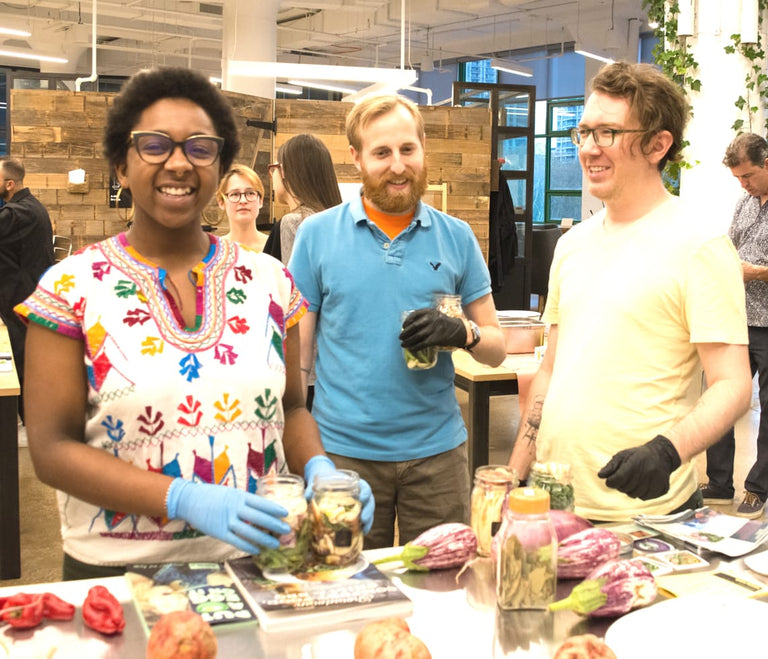Crop Planning 101
“The overall push is to not just grow the cool stuff that people see at a farmers market, but to grow the heirloom, rare, more wild looking, more interesting varietals for Local Roots.”
Ever wonder how Local Roots delivers such a unique and diverse array of produce every season? We check in with Jon Katz, sourcing manager at Local Roots NYC, to learn about what goes into planning and producing your weekly share. Get a behind-the-scenes look at how we do it through our direct farmer relationships and collaborative crop planning.
----------
LR: Talk a little bit about crop planning - what does that term mean? What does that process look like generally?
JK: Crop planning is a process by which a buyer and a seller, typically a farmer but occasionally a middle person, plans upcoming seasons. A lot of it is based on whatever crops have done well in the past - that’s the majority of stuff that’s planned for - and usually there’s a small amount of untested crops, so that’s like an experiment.
LR: So what does that look like at Local Roots?
J: At LR there are a couple things to keep in mind when crop planning... It’s important to not overload the share members with similar crops every week. There are lots of leafy greens in early summer, but if I were to send three or four leafy greens, our share members wouldn’t be too happy, even though it’s the season for that. The other thing is to have more diversity longitudinally, so not only per week, but seasonally. You want to make sure you give folks the greatest number of different items, so if you send cherry tomatoes the second week of July, make sure to not send them again until, say, the second week of August.
The planning process is largely collaborative. We’re looking to tailor the farm’s offerings and shape what they have available for our subscribers. But ultimately they have the final say, since they know their environments and capabilities. [The farmers] are much more bounded than we are - we can buy hundreds of items, they can grow dozens, so that’s part of why we work with different suppliers to make sure our needs are filled.
LR: Where you’re able to, how do you and the farmers decide which varieties to grow each season?
J: What I pushed for with Taproot [Farm] was to grow the more extraordinary varieties... One of the things I focused on with the Brooklyn Grange Rooftop Farm as well was, instead of growing your standard green kohlrabi, they’re growing a white and a purple. For Taproot, instead of growing your standard butternut squash, they’re growing this 898 honeynut experimental squash, which is bred for flavor. The overall push is to not just grow the cool stuff that people see at a farmers market, but to grow the heirloom, rare, more wild looking, more interesting varietals for Local Roots. A lot of the local organic farmers do have presences at the farmers market, and what’s to stop folks from buying what they want at the farmers market versus what we have? So really what we have are more unique varietals that are only available via Local Roots.

LR: What are some of the challenges of crop planning generally? What are the disadvantages of committing to growing produce for Local Roots?
J: They’re two sides of the same coin. We plan in the Winter for harvests in the Summer and Fall - up to sixth months ahead. Without us having exact sales ideas, we can’t ask [the farmers for accurate] amounts. We have a little bit of leeway - people may not know, but Local Roots provides crops for one of the NYULangone Health kitchens, so that outlet can be used to absorb extra product, but even then only a small amount every week.
Likewise, without knowing what our exact buying power will be, the farmer runs the risk of having inventory on hand that can’t be sold. If the farmer is growing 600 units and we only have demand for 500, the farmer is left which a bunch of unsold products, and potentially at their farmers market, they can’t sell 100 units of white kohlrabi. That could dissuade farmers from growing unique items for us in the future, because if you say you’re going to take one action and you take a different action, it shows that you’re not really standing by your word.
LR: So people’s purchases really do have a direct impact on farmers’ livelihoods… On the flip side, what are the advantages of growing for Local Roots?
J: Usually there are a lot of questions farmers have of what to grow because they’re not certain what the demand will be. When you sign up for Local Roots it allows us to plan with farmers to create specific amounts to grow. [Because our members prepay in advance, farmers] know we’re going to buy their product and it allows them the security to test-grow varietals that they might not normally. If you’re growing something you’ve never grown before, there’s no guarantee that anyone will buy it and you could be left with quite a lot of inventory. If you’re growing for someone, there’s a chance you might end up with a small amount of inventory, but either way you’ve got security. If it ends up working and the crops flourish, you know that this is one more card up your sleeve for growing in the future.
“A lot of the local organic farmers do have presences at the farmers market, and what’s to stop folks from buying what they want at the farmers market versus what we have?”

LR: So what does this all mean for subscribers? What benefits does crop planning have for Local Roots members?
J: When you sign up with any CSA you’re allowing the farmer to grow food for you. With us, you’re getting something tailored directly for more refined palettes in New York City, and you’re getting produce that would be tough to get otherwise. You’re also supporting multiple farms, which is cool. When you sign up for a traditional CSA you’re getting produce from one farm - [our model] allows us to spread the love a bit, but still support farms in Brooklyn, in PA, and in upstate New York.
LR: I know you’re working with some farmers to grow special varieties of greens - can you talk about that as an example of how the planning process works and what our relationship with our farmers looks like?
J: Our farmer George actually came up with the idea. He had grown some interesting Asian greens for us last season and asked if we wanted to expand our offerings. There are quite a wide variety of Asian greens and we have them in the shares quite a bit this season. We’re growing hon tsai tai, which is a flowering broccoli, bok choy, gai lan, and komatsuna. If folks have these items, they generally have them at a restaurant because they’re not widely available in most supermarkets. If you go to an Asian supermarket, you may be able to find some of them, but they’re very unlikely to be grown locally because local farmers don’t have a market to unload them to. Most of the farmers in the area are not selling directly to Asian supermarkets, they’re selling in traditional ways, so the Asian supermarkets that would sell komatsuna or gai lan are forced to buy from conventional farmers in California. And this is just a taste - no pun intended - of the really neat stuff that George is growing.
[Wen-Jay, Local Roots founder jumps in]: George and I have been talking for 2 years about some dream greens and I really was pushing for the Asian greens. Based on the flavor of his other vegetables, I thought it would create a great flavor profile for Asian greens: sweet and peppery. From a cultural standpoint, I was excited to bridge my own Chinese heritage with my passion for local food, it was a perfect marriage.

J: There’s a whole bunch of really amazing stuff that's coming this season. The big difference between this season and last is that [previously] I would often buy [George] out - there would be a particular crop that looked good and I would be able to fill say 70% of the shares with them, so I’d supplement with something from a different farm relationship. This season, with him planning directly for us, my goal is to cover all of our shares with the same product. That will streamline operations, since everyone gets the same thing [instead of coordinating between a few farms to sub in the missing quantities], and smooth out differences between shares, so that’s a huge help.
------
Check out what we have in store this Summer and subscribe today to try all the new things our farmers are growing for us!
Article by Sophie Neuhaus, farm to city Local Roots apprentice
Rather have a taste first?
Local Roots Experiences are fun, pop-up events where we bring the farm to you!

Become a Harvest Club Pick Up Location
Are you a NY based cafe, bar, or neighborhood business? Become a Harvest Club pick up location and have community members come to your establishment each week to pick up their Local Roots harvest.
Top







